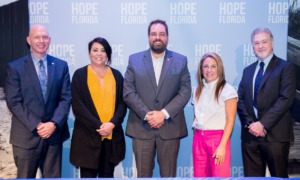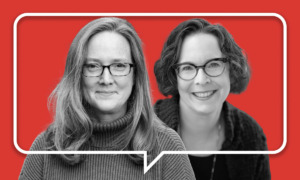Portland, Ore.
One of the first things Catherine Milton noticed when she became president of Friends of the Children (FOTC) three years ago was the huge map on her office wall, dotted with stickpins denoting 18 possible expansion sites.
Thanks to favorable publicity, FOTC had been fielding dozens of calls a month from people who wanted to start new chapters. “Everybody was in this mode of building, building, building, and defining success as being in more places,” Milton recalls. “I thought, ‘Whoa. We need to slow down until we have a plan. We need to figure out the right way to do this.’ ”
Today FOTC emphasizes quality and sustainability rather than growth. Although a new chapter opened in Boston last year, two sites have been shut down, and another lost its affiliation. Alarmed by some findings in its annual evaluations, the flagship chapter here is emphasizing academic improvement and preparing adolescents for adulthood. And Milton spends much of her energy helping to secure funding for a $5.3 million, four-year randomized study.
Those changes will be part of Milton’s legacy, as she prepares to leave FOTC this summer at the end of her contract. The agency’s evolution provides a case study of the growing pains that an organization experiences as it tries to expand nationally. (See “Research of Note,” May.)
Launched in Portland in 1993 with three mentors serving 24 children, FOTC now has 80 paid mentors working with 600 children in nine cities. Depending on the site, the annual per-child cost ranges from $6,100 to $10,000. Although each chapter raises and budgets its own money, the chapters’ budgets would total almost $7 million a year if combined with that of national headquarters.
 The model is straightforward. Each spring, using objective screening tools and subjective observations, FOTC selects a group of kindergarteners whose family circumstances put them at risk for school failure, early parenthood and delinquency. FOTC promises each child an intensive relationship with a “Friend” through high school – an extraordinary commitment of 16 hours a month of one-on-one time. The Friends promise to be more than mentors: They also connect children to academic, social and health services.
The model is straightforward. Each spring, using objective screening tools and subjective observations, FOTC selects a group of kindergarteners whose family circumstances put them at risk for school failure, early parenthood and delinquency. FOTC promises each child an intensive relationship with a “Friend” through high school – an extraordinary commitment of 16 hours a month of one-on-one time. The Friends promise to be more than mentors: They also connect children to academic, social and health services.
By hiring well and paying each Friend up to $31,000 a year, FOTC has reduced the turnover that plagues volunteer mentoring programs. Research by Child Trends has found that mentoring programs can significantly improve outcomes for kids only if they are well-structured, and if the relationships between mentors and children are long-term and intensive.
In Portland, for instance, seven of the 35 Friends have been with the program for a decade; the average Friend stays six years. Most children in the Portland program will have no more than three mentors over 12 years.
In fact, the children’s mobility is a bigger problem than the mentors’. Although all children in FOTC-Portland are chosen from four elementary schools, moves and school changes have spread those children to 90 schools in five counties.
Inspiration
The concept for FOTC grew out of the childhood experiences of Duncan Campbell, a timber industry tycoon, combined with the lessons he learned as a juvenile detention worker and an appointee to numerous commissions on at-risk children.
Campbell, 60, grew up in the poor Portland neighborhood where FOTC is headquartered. With both parents being alcoholics, he says, he basically raised himself. Various adults helped him along the way, planting in him an appreciation for adult role models. “I know that it was the relationships and the values that came from them that helped me with life,” he says.
As a young man, Campbell worked for several years in detention facilities in Portland and Eugene, Ore., and became convinced that many children were not getting guidance at home. Although Campbell went into business after finishing law school, he kept a foot in youth work, chairing the Multnomah County Juvenile Services Commission and serving on the board of Children First and on a state task force that redesigned children’s services. The experiences informed him, but they also frustrated him. “I didn’t really see much change,” he said.
In 1990, when he sold his timber business, he decided to use some of his wealth to help kids. “I wanted to see one child’s life changed before I died,” he says.
Critical to fulfilling that vision was a friendship with Oran Bolstad – a child psychologist who headed Morrison Center, Portland’s largest outpatient mental health agency – that grew as they drove to and from task force meetings in Eugene.
“I remember one day Duncan asking me, ‘If you could have any job, what would it be?’ ” recalls Bolstad, an expert on risk and resiliency in youth. “I talked about how I would like to start a think tank to bring to the community’s attention the kind of collaborative programs that could make a difference in the lives of children. He said, ‘I’ll hire you to do that.’ ”
In 1992, the Campbell Institute for Children opened, with Bolstad as its director. Bolstad spent nearly a year looking at programs for disadvantaged children around the country. Campbell sometimes went along. On a visit to Baltimore, they got the idea of paying mentors.
“A mentor casually mentioned that he could do a great job if he could devote himself to seven or eight kids and work full time as a paid employee,” Bolstad recalls. “On the long flight home, we talked about it. We thought, ‘Why not?’ ”
Bolstad went to work designing a model. And in 1993, Campbell hired Mike Forzley, a crony from juvenile court, as the first executive director of Friends of the Children. Campbell wrote a check for $1.5 million to cover start-up costs and three years of funding. (He has since donated another $500,000 for an endowment.)
Growth
Campbell made it clear that he didn’t want to serve the cream of the crop. That first year, FOTC-Portland hired three mentors, dubbed them Friends, and chose 24 children from three schools with high poverty rates. They included Campbell’s alma mater.
“A friend of mine once said to me, ‘You’re helping little Duncans,’ ” Campbell recalls. “But that’s not true. I had some sort of natural resilience that helped me overcome my circumstances. But at Friends, we want to work with the children who are most at-risk and most vulnerable, those who have the least internal resilience. We don’t pick those who will make it without us.”
Other benefactors soon chipped in. Oregon’s largest foundation, The Meyer Memorial Trust, gave $40,000 in 1993, and has since given $905,000 more. Then came grants from U.S. Bank and the F.B. Heron and Hasbro Children’s foundations.
Every year, FOTC-Portland added three mentors and another 24 children. As word spread of the approach, replication requests came in. In 1996, FOTC allowed the Fellowship Foundation, a Christian group in Washington, D.C., to start an FOTC chapter at The Little White House, its youth center in a poor section of the city.
In 1998, Public/Private Ventures (P/PV), a Philadelphia-based research organization, conducted a preliminary assessment of FOTC’s effectiveness and its replication potential. P/PV concluded that FOTC was a mentoring program “worthy of further investigation.”
“I don’t casually toss words around like ‘brilliant’ and ‘unique,’ but what Campbell did is brilliant and unique,” P/PV President Gary Walker said then. “What he created in Portland could change the way this country tries to help its children.” In 1999, FOTC authorized a new chapter in Chester, Pa.
Because the original FOTC board wanted to concentrate on the Portland program, Campbell created a new nonprofit in 2000 to oversee expansion. Doug Stamm, a former Nike executive, came in to head Friends of the Children National. At about the same time, P/PV obtained a $298,200 grant from the Robert Wood Johnson Foundation to evaluate the feasibility of expanding.
Even before the P/PV study was finished, however, FOTC authorized new sites in 2000 in Seattle; Cincinnati; Klamath Falls, Ore.; and New York City. The next year it added San Francisco; Wilmington, Del.; Salem, Ore.; and Eugene. The Cincinnati,
Salem and Eugene sites departed from the original model, with public money paying most of the costs.
By now, the national press was paying attention. FOTC received laudatory treatment in Parade and People magazines. “Our goal is to open 10 programs in the next two years,” Stamm told Parade.
Catherine Beckett, director of curriculum, training and evaluation, recalls it as an unnerving time. “We had six or seven brand-new chapters, but we weren’t quite sure we had a solidified model,” she says. “Portland was still learning quite a bit. Then there was the question of who had the authority to say what this model is going to be. Chapters were doing their own thing.”
Bolstad, the architect of the model, joined the national board and urged caution. “The people in Friends were feeling a sense of affirmation that other cities wanted to replicate it,” he recalls. “But I don’t believe in making long-term commitments to children and families unless you can guarantee your commitment. It became our most critical and dominant issue over the last three years.”
Adjustments
In the spring of 2002, Stamm left FOTC to run the Meyer Memorial Trust. The board looked for a successor with experience in winning grants from national funders and growing an organization.
It found Milton, who had worked most recently as executive director of the United States branch of Save the Children and had been senior vice president of the Corporation for National and Community Service when it launched AmeriCorps and Learn and Serve. Milton liked the FOTC model. “I believe in ideas,” she says. “I thought that the Friends approach could really make a long-term difference for children. It just needed a chance to grow and be proven.”
Within two weeks of taking over, however, Milton concluded that FOTC had grown too fast. Some of the chapters had serious money problems. “I realized that the highest priority had to be strengthening the program and the current chapters and getting a clear strategy about growth,” she says.
FOTC had had preliminary talks with the Edna McConnell Clark Foundation about funding, and Milton set out to nail the grant. In September 2003, Clark awarded FOTC $1.5 million over three years to develop a sustainability and expansion plan. With the help of the Bridgespan consulting firm, FOTC underwent an intensive strategic planning process. The board also adopted a theory of change, including three measurable outcomes for each child: avoidance of involvement in the criminal justice system, avoidance of early parenthood, and graduation from high school or attainment of a GED.
This self-examination led FOTC to make some hard choices last year. It disaffiliated the Washington, D.C., chapter over the chapter’s reluctance to submit to evaluation and its increasingly religious tone. In Oregon, FOTC shut down the Salem and Eugene sites because state funding ran dry. Forty-eight children at those two sites lost their mentors. “It was extremely painful,” Milton says.
More hard work lies ahead. The board realizes that a good longitudinal study is needed to prove the model’s effectiveness, but randomized studies – the gold standard – are expensive. The board is pursuing a multi-pronged strategy to finance one.
At the board’s behest, Rep. Earl Blumenauer (D-Ore.) has introduced a bill to authorize $7.5 million a year for five years for a demonstration project, which Milton says would help with the evaluation costs. And this fall, P/PV and the Oregon Social Learning Center plan to apply for a $5.3 million evaluation grant from the National Institutes of Mental Health.
At the same time, the model continues to evolve even as the board searches for Milton’s successor. With 280 children and about 35 Friends, FOTC-Portland provides a good laboratory for tinkering. When it became clear a few years ago that reading scores were lagging, Portland required each Friend to devote an hour a week to reading, a requirement likely to be imposed on all chapters.
Initially, Campbell admits, FOTC believed so strongly in the power of the Friend/child relationship that “we just couldn’t imagine that these kids wouldn’t catch up in their reading.” Campbell now uses the term “intentional mentoring” to distinguish what the Friends do from “just hanging out.”
As the only chapter that’s been around long enough to see its kindergarteners grow into adolescents, FOTC-Portland also provides valuable lessons about working with adolescents. Some one-on-one time is being replaced with group activities that teach independent living, job readiness and college application skills.
Although FOTC is run by professionals, it’s still very much Campbell’s baby. He still chairs the national board, and few days pass without him stopping by to check on things.
As for whether he’s satisfied his goal of changing one child’s life, Campbell points to the program’s original 24 children. Eight moved too far away to continue to participate, and two dropped out. But 14 stuck with it to the end. One earned a GED, and eight graduated from high school. Of these, six became the first members of their families to earn a diploma. Four have enrolled in college.
“We have the courage to say you’ve got to start young,” Campbell says.
Resources
Duncan Campbell, Board Chairman
Catherine Milton, President
Virginia Silvey, Executive Director, Portland Chapter
Friends of the Children
Portland, Ore.
(503) 281-6633
www.friendsofthechildren.org
Evaluation Findings
From its inception, Friends of the Children has kept detailed information on each child’s progress and has undergone annual evaluations by outside experts. “We’re a learning organization,” says founder and board chairman Duncan Campbell. “We want to know what results we are getting.”
Last year’s evaluation of FOTC-Portland, by NPC Research of Portland, reported a combination of positive and negative findings among 238 youths it studied. They accounted for 89 percent of the youth in the program. FOTC says this reflects the profound challenges faced by the children it selects.
Among the positive findings:
• Ninety-nine percent of adolescents said their lives had gotten better because of FOTC.
• Ninety-six percent of adolescents reported being positively engaged in school.
• Four percent of FOTC-Portland adolescents dropped out of school in the 2003-2004 school year, compared with 10 percent of Portland adolescents overall.
• Teachers rated 87 percent of FOTC’s elementary and middle school children high on a scale of “social abilities.”
• Five percent of FOTC youth reported ever carrying a weapon, compared with 11 percent of Multnomah County youth.
• Eighth- and eleventh-graders used alcohol at a lesser rate and marijuana at about the same rate as other Portland youth.
• Eighty-seven percent of participants had no school disciplinary referrals in the 2003-2004 school year, compared with 72 percent four years before.
There were also some causes for concern:
• About one-fourth of the adolescents showed symptoms of depression, including suicidal thoughts, compared with 10 to 15 percent of adolescents nationally.
• Almost two-fifths of the high school students reported being sexually active, a slightly higher rate than among Portland youth in general.
• Teachers rated more than one-quarter of the FOTC elementary and middle schoolers as making poor academic progress. Only about half were reading at or above grade level, and fewer than half were performing at or above grade level in math.
• Eighth- and eleventh-graders were trying tobacco at a higher rate than all Portland youth.
• Eight percent of FOTC adolescents were involved with the juvenile justice system, compared with less than 1 percent of all Portland youth. (One explanation is that about half of the FOTC-Portland children are African-American, compared with 9 percent of Portland children. African-American youth in Multnomah County are 2.5 times as likely as white youth to be referred to juvenile court.)
FOTC President Catherine Milton says that comparisons between FOTC children and all Portland children are not apt, because FOTC children are selected because they are at risk for academic failure and delinquency. The randomized study for which FOTC is seeking federal financing will track how FOTC children compare with a control group of equally at-risk children.
“When I would worry about some of the stats, Jean Grossman would say to me: ‘If you have really good stats, you’re not dealing with the right children,” says Milton, referring to the director of research for Public/Private Ventures.
A report by P/PV last year on paid mentoring programs such as FOTC concluded that “effectiveness evidence is thus far quite limited,” but that they have produced “an intriguing and positive track record.”






























